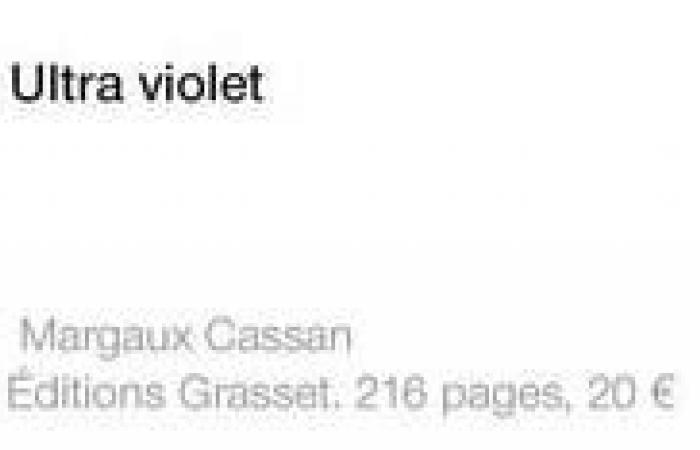Comments collected by Maïté CHARLES.
Through a philosophical investigation combined with an autobiographical story, the author Margaux Cassan aims to demonstrate how tanning is a social marker, a time associated with success or good health, but which is today more than criticized .
What if the obsession with golden, even tanned skin was not just an aesthetic quest? This is what Margaux Cassan, philosopher, says in her book Ultra violet, published by Éditions Grasset on October 9, 2024. In this work combining personal story and philosophical investigation, the author wishes to define tanning as a “social fact”. Interview.
Margaux Cassan, why write about tanning when you are a philosopher?
I was quite frustrated with the contempt of philosophers on the question of the body, and I therefore wanted to make a contemporary philosophical story which completely embraces questions of the body, because when these are treated in the press, the body is considered under two prisms only: sexuality and food. I therefore thought that philosophy could provide other methods answering the question “what is Man?” “.
From a personal point of view, the news of my mother’s skin cancer made me want to write this book. I remember my incomprehension when the first thing she did, after having the operation, was to go back out into the sun. I therefore wanted to intimately and philosophically question our relationship to risks.
Read also: From translucent skin to tanned complexion, the great story of tanning
When did you realize that tanning wasn’t just a cosmetic issue?
For my mother, tanning is more than an activity, it really is an identity. She used tanning as a social, even socio-economic, identity. According to her, having tanned skin showed one’s success to society. My mother grew up in the Paris suburbs, so she crossed the ring road and for her, showing tanned skin was supposed to send a signal. It was as if mastering your body to perfection was tantamount to mastering your career.
On the historical aspect, you return to the period of paid leave in 1936 and how this social revolution changed the relationship with tanning…
Between 1935 and 1985, there was a form of cultural revolution where tanning, which was initially associated with hard work and therefore with workers, became a right and a social achievement. People having fought to obtain paid leave, the tan, in 1936, was proof that they had obtained it and that they could go on vacation. This positive association of tanning as an achievement, a right to laziness, held up until the 1980s, when the dangers of the sun were unearthed.
Read also: Sun addiction has a name: tanorexia
After 1936, tanning became the cure for all ills…
Even the medical profession believed that the sun was bactericidal, that the rays were so hot that the bacteria were burned. As European societies were engulfed in war and epidemics continued, the sun became a means of healing. Hospitals were built with a southern exposure and a particular architecture: the system of terraced stands, which allowed the sick to be placed on a stretcher, in underwear, exposed to the sun all day. And since the sun releases endorphins, people really felt like they were doing better.
How do you explain the fashion for tanned complexions, in winter as in summer, in the 1980s?
The war was over, so at the time, we were dealing with a generation of enthusiasts. It is also a generation of post-Christian societies, where the relationship with authority has completely collapsed. In previous generations, people lived in fear of war and successive authorities: the authority of God, the authority of the Church, and the authority of the State. When capitalism, associated with democracy, developed more consumer societies, there was a sort of acute adolescence of individuals, with the impression that all authorities had fallen. This gave a faith in one’s own life, in one’s own career, a feeling of absence of obstacles, which justified that one could make a performance out of one’s body. Tanning has become a desire for signature, for strengthening one’s individuality.
Read also: Eight preconceived ideas about the dangers of the sun
You use the figure of Rastignac, the famous hero of Balzac, to talk about the “Rastignac of the sun”. Who are they?
This is the figure of the upstart used by Honoré de Balzac in his books. He is a special type of upstart who used skin to succeed, who is now between 55 and 80 years old. I’m thinking of Jacques Séguéla, Jack Lang, and even Donald Trump!
What does today’s society have to do with tanning?
It’s not really out of fashion, but it’s a more paradoxical relationship compared to the 1980s. Today, tanning is definitely associated with skin cancer and therefore death. Our generations associate the sun with a threat, because of global warming and heat waves. But on the other hand, we always consider that the brand of swimsuit is sexy, that the most chic thing is to have the “ski tan” with just the tanned face, with the brand of glasses.
So has tanning become obsolete?
What is outdated about tanning is this particular form of tanning that the “Rastignac of the sun” have, that is to say, tanning all year round, at all costs. We can also see this in the decline of tanning beds.
This marker of success, which was very popular in the 1980s, has been viewed with contempt for around twenty years. Today, being tanned all year round is associated with the nouveau riche. We are now in a protective society where danger and risk-taking are not valued, unlike the 1980s, where there was a form of carelessness encouraging risk-taking at all levels.









